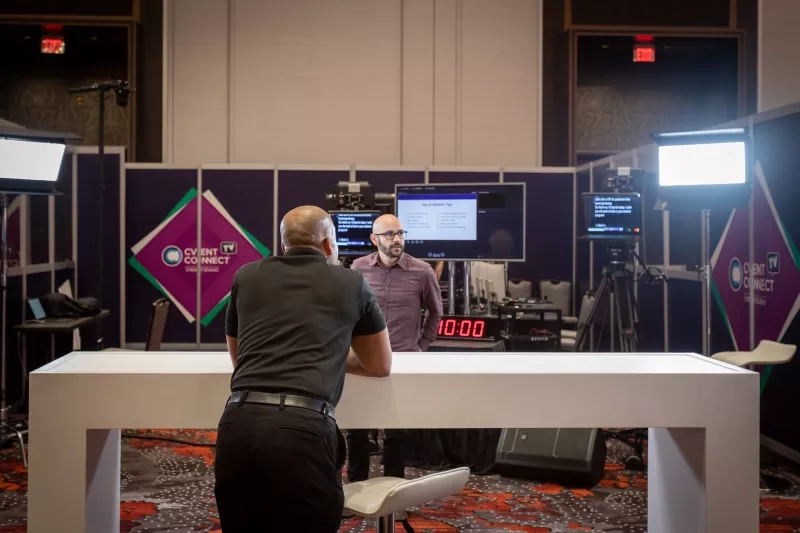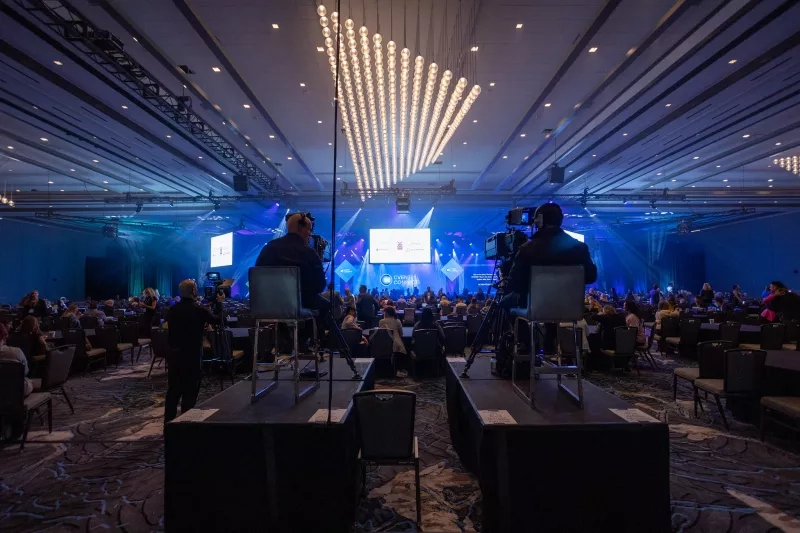As associations’ events programs evolved over the past several years, hybrid events have become a key format to maintain the broad reach of members achieved through virtual events in 2020 and 2021. Hybrid events bring together two distinct experiences - one in-person and one virtual, into one centralized experience.
With corporations and organizations reevaluating travel budgets and associations desiring to promote events to as many members as possible, hybrid events are rising in popularity. Done well, they combine the undeniable value of in-person interaction with the exponential reach of virtual events to maximize the event’s appeal for all involved.
While the idea of doing a hybrid event may seem complex in technology or resource bandwidth, it doesn’t have to be. Association planners can produce hybrid events that are within budget, don’t overwhelm staff and, most importantly, benefit their members.
There are more design and technology solutions available to support events that will maintain an online component than ever before. Now associations have a chance to build great value based on the unique experiences only possible when together onsite, plus the accessibility and adaptability of online formats.
What is a Hybrid Event?
Hybrid meetings represent the best of both worlds for events professionals--but they do come with an inherent set of challenges. While all your events have individual goals, an overarching goal for all hybrid events is to engage as many attendees as possible--virtual and in-person.
A hybrid event allows people to meet in person if they want that human connection experience. A hybrid meeting also allows those who otherwise would not have been able to attend due to health concerns or travel constraints, the flexibility to engage virtually. For planners and marketers, the challenge is to make the experience equally engaging for both groups. By reducing the barrier to entry, hybrid events provide the opportunity for even more people to interact with your content and your brand.
There are many ways to structure a hybrid event. Here are some examples:
- An event with two different attendee experiences (online and in-person) going on at the same time
- An in-person event with sessions and other activities/ that are live-streamed to virtual attendees
- An in-person event, with on-demand content, offered afterward for those who want to see the content virtually
- An in-person event and a virtual event – with similar content and branding, but on different days
Within these different formats, you might have variations as well. For example:
- Different speakers for virtual audiences than for in-person audiences
- Different content types for each audience – for example, in-person content might be presented as hands-on or workshop learning, while virtual content might be presented in a lecture or panel format
Don’t be constrained by what format your hybrid event can take on - find the right balance for your association between member experience, sponsor value, and your association’s resources.
Understand What Your Members Want
To structure your hybrid event to maximize both in-person and virtual attendance, you’ll want to have a strong understanding of the ways in which your membership wants to engage and what they are seeking out of each experience. Ask specific questions about what content and programs your audience is most interested in for both live and virtual offerings. Specific questions about virtual events might include:
- Do you need matchmaking with products, services, or individuals?
- Are you looking for an online career fair?
- Do you want online networking?
- Do you want to watch content live?
- Do you want to ask questions of the speakers?
Your association needs to ask them what they’re expecting from the digital experience. It’s becoming more widely understood that in-person attendees are prioritizing networking and face-to-face interactions. So, what does this mean for content structure? They’re less interested in listening to talking heads; instead preferring small roundtable discussions on a current topic. If survey results reveal a high portion of respondents are prioritizing hybrid items, this doesn’t necessarily mean the organization needs to go through the expense associated with live streaming everything and trying to put on two events simultaneously. Focus on the most important aspects of the hybrid experience that members want. Associations are most likely to have a successful hybrid event, measured by registrations and survey feedback, if they understand and plan for the experiences both audiences are prioritizing.
Build One Event for Two Experiences
As stated above, one of the biggest mistakes with hybrid events is thinking that if it’s one event, it’s one attendee experience. The best way to avoid this is to approach the in-person and online experiences as two separate events. Distinctly catering events to those attending in-person and those attending virtually allows for both groups to get a full experience out of an event.
It may sound easy, but it requires almost separate planning processes to ensure equal experiences. Creating equal opportunities to engage with the content of your event, participate in events, and network with all attendees is crucial to hosting a successful hybrid event. At the end of the day, attendees need to feel like they are getting value out of your event, whether they attend in-person or online. Approaching event planning as a dual experience makes it more likely for you to achieve that goal.
As you think about the critical differences in member experiences, remember there may be some similarities too. For instance, in-person attendees won’t want to sit quietly and just listen for too long; nor do virtual attendees want to sit in front of a screen too long. As you take your membership’s feedback and structure your hybrid event experience, you will want to consider the impact of the following:
- Session duration
- Number of sessions per day
- Differing registration paths for attendees
- Differing sessions for member interests
- Facilitating networking and a sense of community
- Sponsorship opportunities
With hybrid events, the trickiest part is delivering the same value, no matter how people engage with or consume the content. The technology and platforms that you use are key aspects of getting this right, so choose carefully. Start by using a platform that allows people using the mobile app (for in-person attendants) and the virtual platform to talk, and plan which elements make sense to live stream for cross-audience engagement. This way, both audiences are seeing the same thing at the same time and can hold conversations through your platform similar to how people would in real life.
In best-case scenarios, virtual attendees can join conferences and participate just as they would if they were there in person. Finding a platform that allows at-home viewers to join in real-time and contribute to the in-person discussion is a different planning requirement from just hosting the event with a live audience.
Whether it’s for your annual conference or a regional member training, Cvent provides a platform to manage, execute, and measure in-person and virtual experiences simultaneously:
- Easily find and manage the right venue based on your hybrid event’s unique requirements
- Configure a safe in-person experience to meet all social distancing, capacity, and safety requirements
- Showcase a seamless, fully branded experience at every in-person and digital touchpoint of your event
- Power two unique experiences at the same time – one for virtual and one for in-person attendees – while also creating shared experiences for all attendees
- Use the Cvent Attendee Hub® with a native event app to keep remote and in-person attendees engaged with content, and one another
- Aggregate the data for all your virtual, hybrid, and in-person events for a unified, up-to-date view of your program
Update your Venue Criteria
Selecting your hybrid event venue should incorporate both on-site and virtual production requirements For virtual attendees, the technology IS the venue, and the venue got a lot more compelling. We’ve all read stories of how the pandemic compressed 10 years of technology innovation into 10 months, and that’s precisely what happened with virtual event platforms. As the pandemic wore on, planners, marketers, and attendees demanded more interactive, immersive experiences. Event tech providers responded by building virtual event experiences that delivered vastly improved content and networking experiences.
Yet just as much as your virtual technology platform matters, you’ll want to ensure that your in-person venue can support the resources required to accomplish a hybrid event well. Venues play a critical role in the success of a hybrid event, providing not only the backdrop for a safe onsite experience but also the technology infrastructure and expertise to power virtual content capture and delivery. Ensure that your venue meets your space, safety, and AV requirements early on, and then partner closely with them and their partners to help your team deliver a great event.
- Select a venue with clear and well-documented safety protocols and policies. You’ll improve on-site attendance if your attendees see the venue’s commitment to keeping them – and your event – safe. Use the Cvent Supplier Network to find the right venue that meets your unique requirements - size, layout, provisions, sustainability, accessibility, and more.
- Rethink your event’s layout and space needs. Use venue diagramming software to ensure meeting spaces and rooms meet safety requirements and your hybrid AV needs. Custom design the in-person event space with Cvent’s easy-to-use Seating and Diagramming visualization tool to ensure your layout meets local safety guidelines and accommodates camera equipment virtual viewing requirements.
- Deeply understand the venue’s ability and its partner network that can be used to support your virtual content capture and distribution needs. From AV capabilities in your session rooms to dedicated studio space, your venue can help you tap into the infrastructure and expertise to ensure your online audience experiences great content.
Deliver Meaningful Content and Connections
Virtual and in-person audiences are evaluating your event based on the quality of session content and connections made. All members, regardless of how they are attending your event, need to feel engaged and inspired by how they are learning and interacting. Developing an agenda and content for multiple participation channels requires a thoughtful strategy. You need to determine what content is best consumed in person and what content may only be delivered virtually, while also having a plan to simultaneously deliver some content both in-person and virtually. Accomplish this by incorporating:
- An agenda that easily identifies which sessions are in-person and which are virtual
- Use a mobile event app with live Q&A and other interactive elements (live polling, Q&A, chat, activity feeds, emoji reactions) to give in-person and virtual attendees equal presence in the conversations
- Discussion rooms for smaller group collaboration
- Appointment scheduling tools for vendors, sponsors, and exhibitors
- Dedicated virtual representatives for attendee assistance
- Virtual-only sessions: offer exclusive virtual content to provide remote attendees with their own unique and tailored experience
- On-demand content offerings post-event
Your association is likely to determine that In-person attendees are primarily seeking small group discussions and building shared purpose face-to-face; whereas virtual attendees are looking for communication and engagement tools to allow for easy interaction and access to conversations on niche topics or specific challenges. Seek to deliver on the mutual goals through your session content and hosting platforms.
Especially for virtual attendees, you will need to create opportunities for communication throughout the presentations. The attendees might not be able to whisper, “Hey that’s a really good idea, we should try that,” to each other when divided by the internet, but you can provide platforms that foster real-time communication. It’s the expanded sense of community through the shared appreciation of the content that brings your members together.
While hybrid events allow associations to open the event to as many attendees as possible, fostering a sense of community and shared interest among all attendees cannot be overlooked. It’s important to extend that in-person attendee feeling of connection and interaction to your virtually attending members, too.
When it comes to networking, your in-person networking opportunities might dominate the programming due to it being prioritized by attendees; whereas virtual attendees might require more structured conversational networking that is content-centered, rather than a free-form or open group. Consider the following when building a sense of community through your hybrid event:
- Provide flexible options for members to join your event, no matter where they are
- Create shared experiences to foster a sense of community between local, regional, and global chapter members
- Craft the right experience no matter how your members engage, whether it’s onsite, through a web-based experience, or from a mobile app
- Use pre-and post-event activities to drive ongoing engagement even after your event ends
After the event ends, consider gating your event content and repurposing it to create a “365” content strategy. Hybrid events take a lot of effort, and if you’re not thinking about how to capitalize on the speaker panels and events, you’re missing out on a wealth of resources. Reusing and repurposing the content from professional and networking events can help you provide value to your members who don’t attend an event.
You might also find some great content to repurpose in a blog or part of a newsletter blast. Part of a successful hybrid event is taking all the footage and content you must use in the future. Events aren’t just a one- or two-day thing, they can become the gift that keeps giving if you think through a 365-day content strategy around them.
Leverage Broader Reach with Sponsorships
Hybrid events have greater registration numbers and a much broader reach than in-person events. Use the increased number of attendees to maximize sponsorship opportunities. Consider approaching key partners to collaborate on a sponsorship package that creatively markets to both audiences and accomplishes mutually beneficial goals, such as speaker sessions or exclusive networking functions.
Sponsors are looking for ways to be positioned as thought leaders in front of just the right industry audiences quickly and efficiently; thus, thought leadership content is the best engagement driver for sponsors – use this to your advantage when leveraging hybrid event content and build your sponsorship packages around this.
When it comes to vendors and exhibitors, focus on creating tactile experiences in person. The chance to experience and discover solutions in-person married with the value of qualified lead generation remains a tried-and-true recipe for exhibitor hall success. Use online appointments and structured opportunities rather than open virtual exhibitor halls to maximize the time investment for both your attendees and vendors.
Consider these additional methods to provide exhibitors and sponsors the brand awareness and lead generation they expect, with both virtual and in-person options.
- Showcase sponsors on your event website, in email communications, and during registration
- Use the Attendee Hub to feature sponsors, provide virtual exhibitor booths with video conferencing, facilitate virtual meetings, enable inbound leads, highlight sponsored sessions, and more
- Use the event app to provide options like branded splash pages, banner ads, sponsored listings and highlighted exhibitors, push notifications, and more
- Provide sponsorship opportunities onsite at your annual conference, including ideas like offering branded check-in kiosks, name badges, lanyards, and RFID mats and overhead trusses
Hybrid Meetings: One Event, Two Experiences
One event—two experiences. This is the reality of hybrid events that’s facing the association industry as we forge our way through 2022. So, mastering these foundational elements and finding the right hybrid meeting technology will help put you and your organization in the best position to succeed. For more hybrid event insights, check out the Cvent Community.
Interested in more resources to help you transition your events to hybrid? Check out our eBook, Hybrid Event Strategies for Dummies, where we discuss essential considerations when going hybrid, including:
- Crafting a hybrid event strategy
- Marketing two experiences for one hybrid event
- What it means to be a "hybrid-capable venue"
- Creating an agenda relevant and compelling for both audiences









